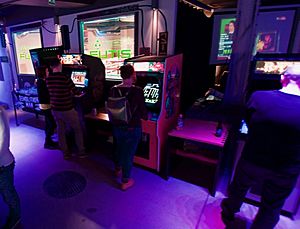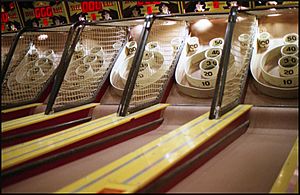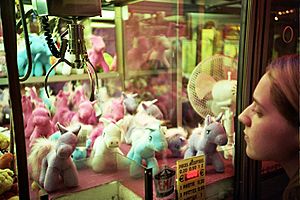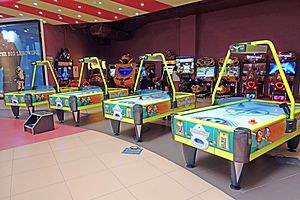Arcade game facts for kids

An arcade game is a fun machine you can play in public places like restaurants, bars, or special amusement arcades. You usually put a coin in to start playing. Most arcade games need your skill to play, like arcade video games, Pinball machines, or games where you win tickets for prizes.
What are Arcade Games?
Arcade games are almost always about your skill, not just luck. Games that are only about luck, like slot machines or pachinko, are often seen as gambling. Because of this, they might not be allowed for kids or need special rules in many places.
Arcade Video Games
Arcade video games first appeared in the early 1970s. Pong was one of the first really popular ones. These games use electronic or computer parts. They take your actions from a joystick or buttons and show them on a screen, like a monitor or television set.
Carnival Games
Coin-operated carnival games are like the games you find at a fair, but they are automated. You often play these games to win prizes or tickets. You can trade these tickets for bigger prizes. Some well-known examples are Skee-Ball and Whac-A-Mole.
Electro-Mechanical Games
Electro-mechanical games (or EM games) mix electronic circuitry with mechanical parts. This means you might move something inside the game cabinet with your actions. Some early EM games were light gun games. You would shoot at targets with a light gun. Examples include Periscope and Rifleman from the 1960s.
EM games use things like motors, switches, solenoids, and lights. They are a step between fully mechanical games and fully electronic games. Some EM games let you pretend to drive cars, steer submarines, or fly aircraft. Others are Gun games where you shoot.
Merchandiser Games
Merchandiser games are where you try to win a prize by doing something physical with the machine. A good example is a claw crane game. Here, you try to move a claw to pick up a prize. Another type is a coin pusher game.
Pachinko
Pachinko is a mechanical game that started in Japan. It can be a fun arcade game. However, it's also often used for gambling in Japan, similar to how slot machines are used in Western countries.
Photo Booths
- Further information: Purikura
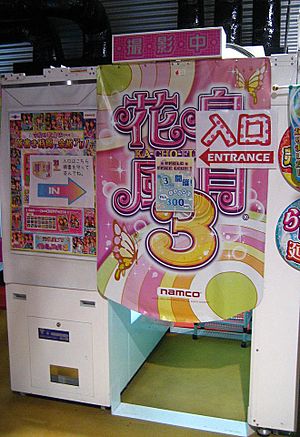
Coin-operated photo booths automatically take and print small pictures of you. Newer ones use digital photography. While some are for official photos like passports, many are designed just for fun in arcades.
In 1975, companies like Taito started making arcade photo booths. These machines used cameras and computers to print self-portrait photos. A special type for arcades is called purikura. These create photo stickers of your selfies. Purikura are like a mix of a photo booth and a video game. They let you change your digital pictures. Atlus and Sega introduced them in 1995. They are very popular in Asian arcades.
Pinball Machines
Pinball machines have a large, slanted table with many targets and scoring features. Players launch a steel ball onto the table. Then, using flippers, they try to keep the ball in play and score as many points as possible. Early pinball games were mechanical. But since the 1930s, they have included electronic parts like lights and sensors.
Slot Machines
In some places, slot machines might be found in arcades alongside other games. However, slot machines are mostly games of chance. Because of this, their use in arcades for kids is very limited. They are usually used for gambling.
Sports Games
Sports games are smaller, indoor versions of popular physical sports. You can play them in an arcade. They often have simpler rules than the real sport. Examples include air hockey and indoor basketball games like Super Shot. Sports games can be mechanical, electro-mechanical, or electronic.
Redemption Games
Redemption games are arcade games where you play to win tickets. You can then trade these tickets for prizes. The better you play, the more tickets you get. Skee-Ball is often played as a redemption game. pachinko is also a very popular redemption game in Japan.
Another type of redemption game is a medal game, popular in Japan and Southeast Asia. Players use special medal coins to play. They can win more coins, which they can then trade for prizes. Medal games are made to feel a bit like gambling, but they follow Japan's strict laws against real gambling.
Skill vs. Chance
Arcade games have often faced challenges to avoid being called purely "games of chance" or "luck." If they were, they would be seen as gambling and have strict rules. Games of chance are usually where you pay to play, and winning is mostly about luck, not skill. Slot machines are typically seen as games of chance. This is why they are usually not found in arcades for kids.
In the 1940s, pinball machines were first called games of chance. This was because after you launched the ball, you couldn't control it much. But after the electric flipper was invented in 1947, players had more control. So, pinball makers argued that pinball was a game of skill. In 1976, a journalist proved this by showing he could aim a pinball shot. This helped lift bans on pinball.
Games like crane games are a mix of skill and luck. You need skill to move the crane over a prize. But the strength of the claw or how the prizes are stacked can be a matter of luck. Most arcade video games are seen as games of skill. You play against the game's programming. However, some video games that look like gambling, such as video poker, are treated as games of chance.
Trade Associations
These groups represent companies that make and sell arcade games.
American Amusement Machine Association
The American Amusement Machine Association (AAMA) was started in 1981. It represents the coin-operated amusement machine industry in America. This includes many companies that make and sell arcade games.
Japan Amusement Machine and Marketing Association
This association represents the arcade game industry in Japan.
See Also
- Amusement arcade
- Arcade video game
- Pinball
- Redemption game


